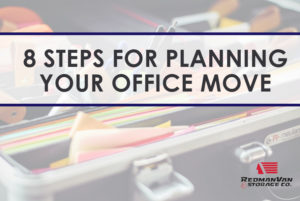September 9, 2016 - 8 Steps For Planning Your Office Move
Moving offices is an exciting time for your company. Whether you’re upgrading to a bigger space or downsizing to a better location, a move is a great opportunity to freshen up your business. However, physically moving all of your employees, equipment, and resources can get overwhelming… fast.
Thankfully, there are ways you can avoid the stress and backlash of an office move. By following these 8 tips, you can properly prepare for and execute a seamless, organized move that keeps business on track, customers happy, and employees excited.
-
Start Planning Early
-
Delegate Tasks To Different Employees
- Choose a senior employee with good multi-tasking skills to oversee the move. This person will be in charge of motivating others and opening clear lines of communication between the staff, brokers, stakeholders, etc.
- Assign a staff member to share the moving budget with the team so that everyone is clear on how much can be afforded during the move.
- Use existing resources to aid in the pre-moving, moving, and post-moving process. Your marketing team, for example, can be a great tool for informing customers about the new, exciting move, while your IT department can get a head-start on ensuring your company’s valuable technology will be in good hands during the transition.
-
Take Inventory
-
Develop A Transition Timeline
- When to begin the packing process
- When you’ll need to have the office entirely packed up
- When and what time the movers will arrive
- When and where your staff will need to be to help unload
- When the office needs to be unpacked
- Grand re-opening dates, moving celebrations, etc.
-
Fine-Tune The Floorplan
-
Prioritize Your Move
-
Check In With Your Moving Company
-
Tie up loose ends
Getting a jumpstart on your move is one of the more reliable ways to ensure a smooth transition. Request copies of the new floor plan and schedule a meeting to inform employees of the move. Encourage them to start planning for the new space. Most importantly, make sure to hire your moving company well in advance. Look for companies with commercial relocation experience or ask other companies in your area for recommendations.
Sit down with your managers and employees and discuss moving strategies. Though this may seem like a non-essential step, making sure that each and every person in your company is on the same page will ensure a stress-free, organized move. Delegate tasks to individuals on your team:
This is a critical tip: taking inventory and knowing the exact quantity of your stock will help immensely when it comes to unpacking and getting settled in your new location. Be diligent about going through all inventory, office supplies, etc. and keep an accurate record of what needs to be moved and what can be donated, thrown away, or left behind. Most importantly, pay special attention to things like client files, documents, and folders that cannot be lost during the move.
Once it gets closer to your office’s moving date, create a specific timeline that highlights important dates and times. Share this with your moving team, and be sure to discuss and clarify critical points on the timeline such as:
Sit down with your team and go over the final floor plan of the new location. Determine and highlight a particular space for each department so everyone knows where they will be located. This will also help your employees better prepare themselves and their supplies, equipment, and personal belongings for the new space. Be sure every area of the floor plan is thoughtfully assigned and make a point of requesting feedback from your moving team.
First and foremost, your move should be scheduled over a weekend or downtime to give your employees the chance to settle in and get business rolling again as smoothly and quickly as possible. One of the most important things to consider while prioritizing your move is that your IT department has ample time to move into the new office and get set up before the whirlwind of boxes, desks, equipment, etc., make their arrival.
Talk with your chosen moving company about your business’s specific moving protocol. Be sure to discuss important preparation measures, what the movers request of your company, how specific items should be moved and unpacked, and if you or the moving company will be in charge of overseeing the disposal of equipment and other items that are not making the move.
With all the details of your move fine-tuned and well-planned, there are only a couple of steps left to take to ensure your office’s move is complete. First, talk to your business’ insurance company about getting temporary moving insurance. This is a good idea for businesses who are making a major move and are moving a substantial amount of valuable equipment, documents, etc. Note that you will have to provide a detailed inventory list and estimated worth of your items, but this shouldn’t be an issue if you followed tip #3.
Lastly, hire a cleaning crew to tackle your old office. Though this may seem like a minor detail, the last thing you’ll likely want to do after executing a major move is deep-clean your old location. You might also consider delegating the task to a few willing employees who are up for taking on the task and making a little extra money.
If your company is making the move to Utah or relocating in the area, count on Redman Van movers to make your transition flawless. With years of experience in the commercial industry, Redman Van is the number-one office mover in the state. Learn more about how we can help you, today!





